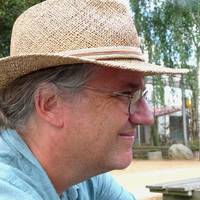The German Institute of Archaeology and the Swiss Institute for Architectural and Archaeological Research conducted the 28 th , 29 th and 30 th campaigns at Elephantine from mid-October I998 to the beginning of April 1999, from... more
The German Institute of Archaeology and the Swiss Institute for Architectural and Archaeological Research conducted the 28 th , 29 th and 30 th campaigns at Elephantine from mid-October I998 to the beginning of April 1999, from mid-October 1999 until mid-April 2000, and from early October 2000 until early April 2001, respectively. After the opening of a part of the ancient town site and the excavation museum to the general public still under the direction of W. KAISER on March I st , I999, the campaigns' priority was the further examination of the finds and the complementary documentation of the excavation's results for publication. Field work was concentrated on the central town site at the area of the palaces of the Old and Middle Kingdom to the south of the temple of Khnum, the south-eastern approaches of the Old Kingdom town, the courtyard of the temple of Khnum, and the area near the Roman monumental staircase next to the city harbour in the north-east. Further investig...
Research Interests:
The 38 season of the German Institute of Archaeology and the Swiss Institute for Architectural and Archaeological Research on Ancient Egypt at Elephantine was carried out from October 30, 2008 till December 15, 2008 and from January 8 to... more
The 38 season of the German Institute of Archaeology and the Swiss Institute for Architectural and Archaeological Research on Ancient Egypt at Elephantine was carried out from October 30, 2008 till December 15, 2008 and from January 8 to April 4, 2009. The work on finds from earlier seasons was continued. This included studies of small finds, seal impressions and lithics dating to the Old Kingdom, pottery of the Old, Middle and New Kingdoms, and the Roman era, Nubian pottery, as well as botanical, animal and human remains. The study of architectural fragments of the temples of Satet of the Middle Kingdom, and the Greco-Roman temples of Khnum was continued, together with the conservation of the wooden columns from the palace bakery of the First Intermediate Period. Excavations were carried out in the area between the temple of Satet and the sanctuary of Heqaib, in the precinct of Khnum, and its later occupation layers and at the south-western part of the town enclosure of the 2 mille...
Research Interests:
Research Interests:
Since 1969 the excavations of the DAI and its cooperative partner, the Swiss Institute in Cairo, on Elephantine Island, have concentrated mainly on the building history of the settlement as well as the study of the temples of Khnum and... more
Since 1969 the excavations of the DAI and its cooperative partner, the Swiss Institute in Cairo, on Elephantine Island, have concentrated mainly on the building history of the settlement as well as the study of the temples of Khnum and Satet and their surroundings, from the Early Dynastic Period approx. 4th mil. BC) until the Late Roman Period (until 642 AD in Egypt). The project "Realities of Life", initiated in autumn 2013, now redirects the focus of the work of the DAI onto the living conditions and daily life of the people inhabiting the Middle Kingdom town (ca. 1980–1760 BC). These scientific aims will be pursued with a strong reliance on archaeometric methods and local scientific cooperation, which could be set up during the initial phase of the project.
Research Interests:
In 2009-2012 the northern area of the museum garden on Elephantine was investigated before the construction of a magazine. This was the area of the north-eastern town extension of the 2nd Dynasty, which was surrounded by a city wall. A... more
In 2009-2012 the northern area of the museum garden on Elephantine was investigated before the construction of a magazine. This was the area of the north-eastern town extension of the 2nd Dynasty, which was surrounded by a city wall. A stone path led from the landing place for ships to a gate. From the 11th Dynasty onwards, the area in front of the city wall was also built on. Among other features, several ceramic kilns from the 12th Dynasty were found here. The youngest phase was a house of the 19th century.
Research Interests:
The paper presents the results of the excavations in 2012 and 2014 in the Prolemaic-Roman village of Philoteris in the Fayoum. The settlement was supplied with Nile water through canals, which could be stored in large basins. The water... more
The paper presents the results of the excavations in 2012 and 2014 in the Prolemaic-Roman village of Philoteris in the Fayoum. The settlement was supplied with Nile water through canals, which could be stored in large basins. The water was drawn from there through simple wells, shadufs and sayqiya stations.
Research Interests:
Research Interests:
Research Interests:
Research Interests:
Research Interests:
Research Interests:
Research Interests:
The article shows the use of a grid of 3 1/2-nbj cubits in an early dynastic building complex.
Research Interests:
Research Interests:
Numerous stone vessels are known from pre- and early Dynastie Egypt. Their appearance and their value in a socio-economic aspect are discussed in this article. Therefore, 3434 stone vessels from 389 tombs were examined and brought by the... more
Numerous stone vessels are known from pre- and early Dynastie Egypt. Their appearance and their value in a socio-economic aspect are discussed in this article. Therefore, 3434 stone vessels from 389 tombs were examined and brought by the dating of the tombs according to their content of pottery and other grave goods into a chronological order. While in Naqada I and II the tombs containing stone vessels are quite equal in the number of vessels found in these graves, from Naqada IIIB on there is a clearly increasing accumultion in a group of richer tombs. Also the used kinds of stones arechanging in this period.
